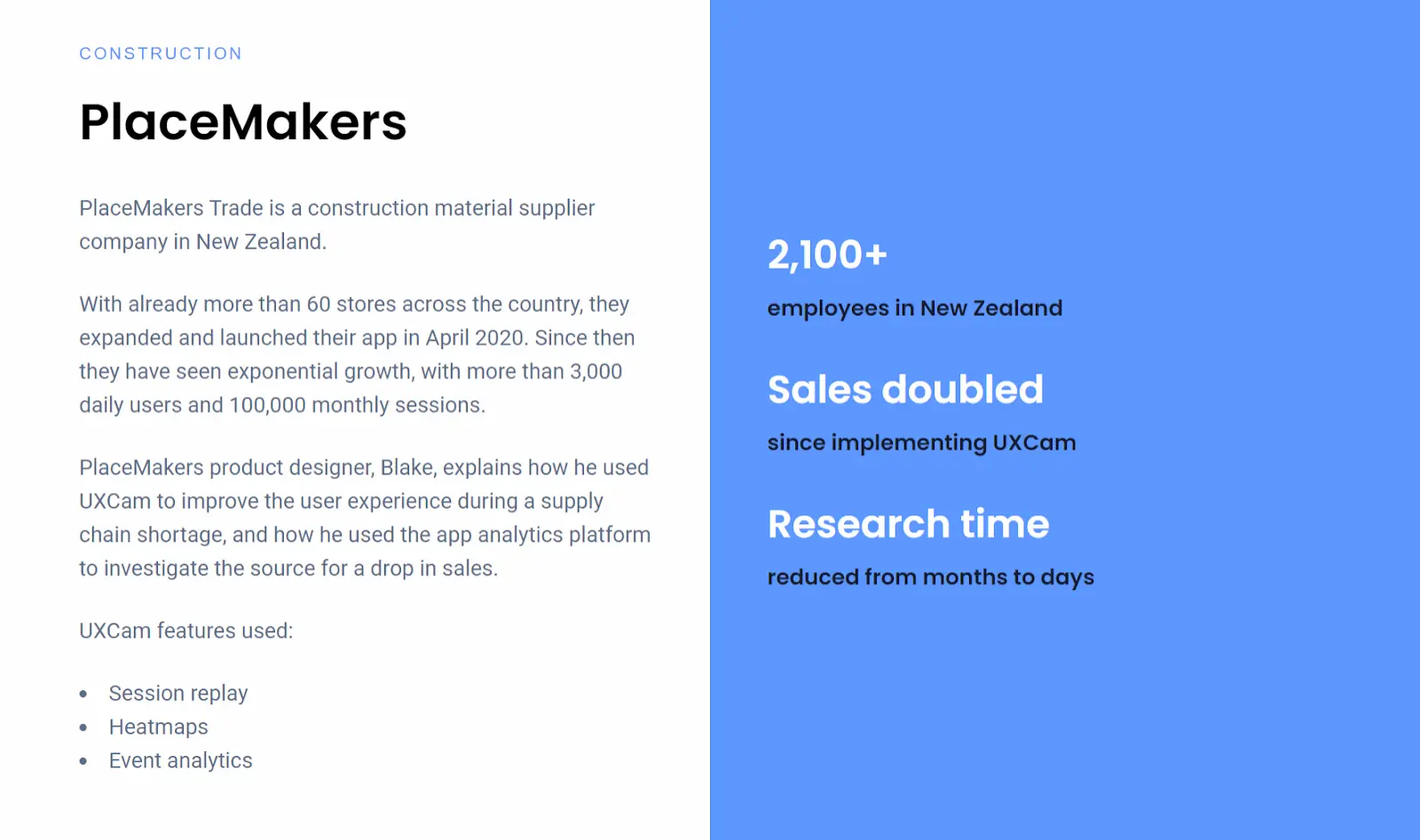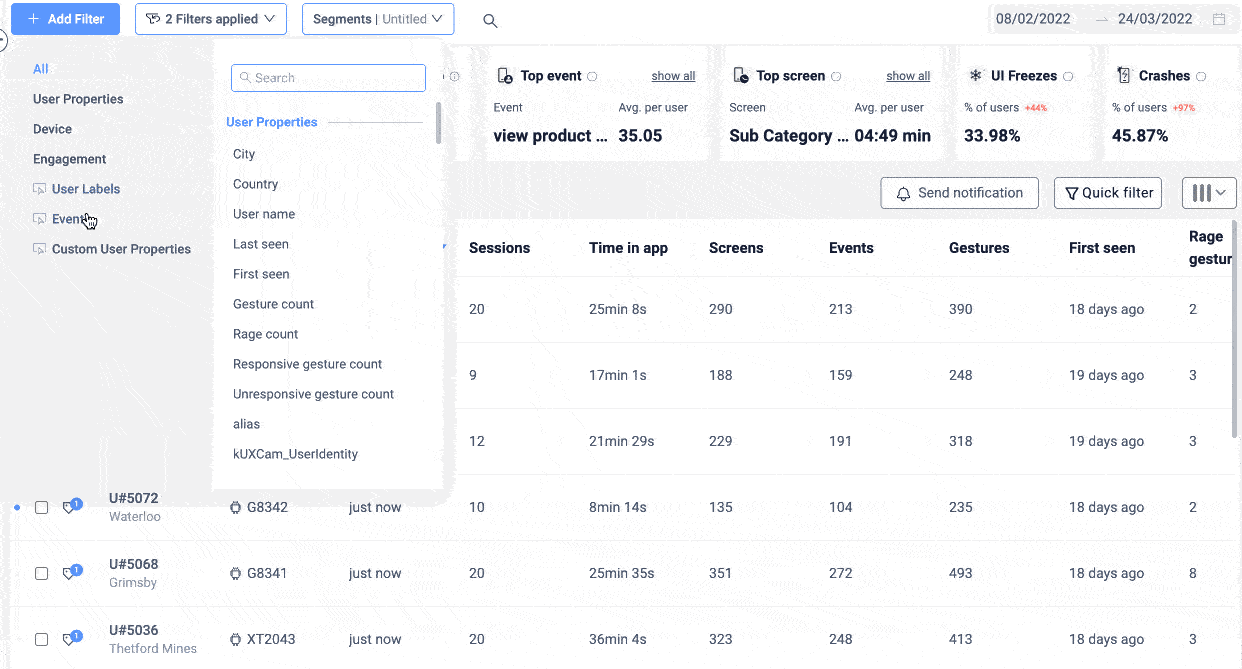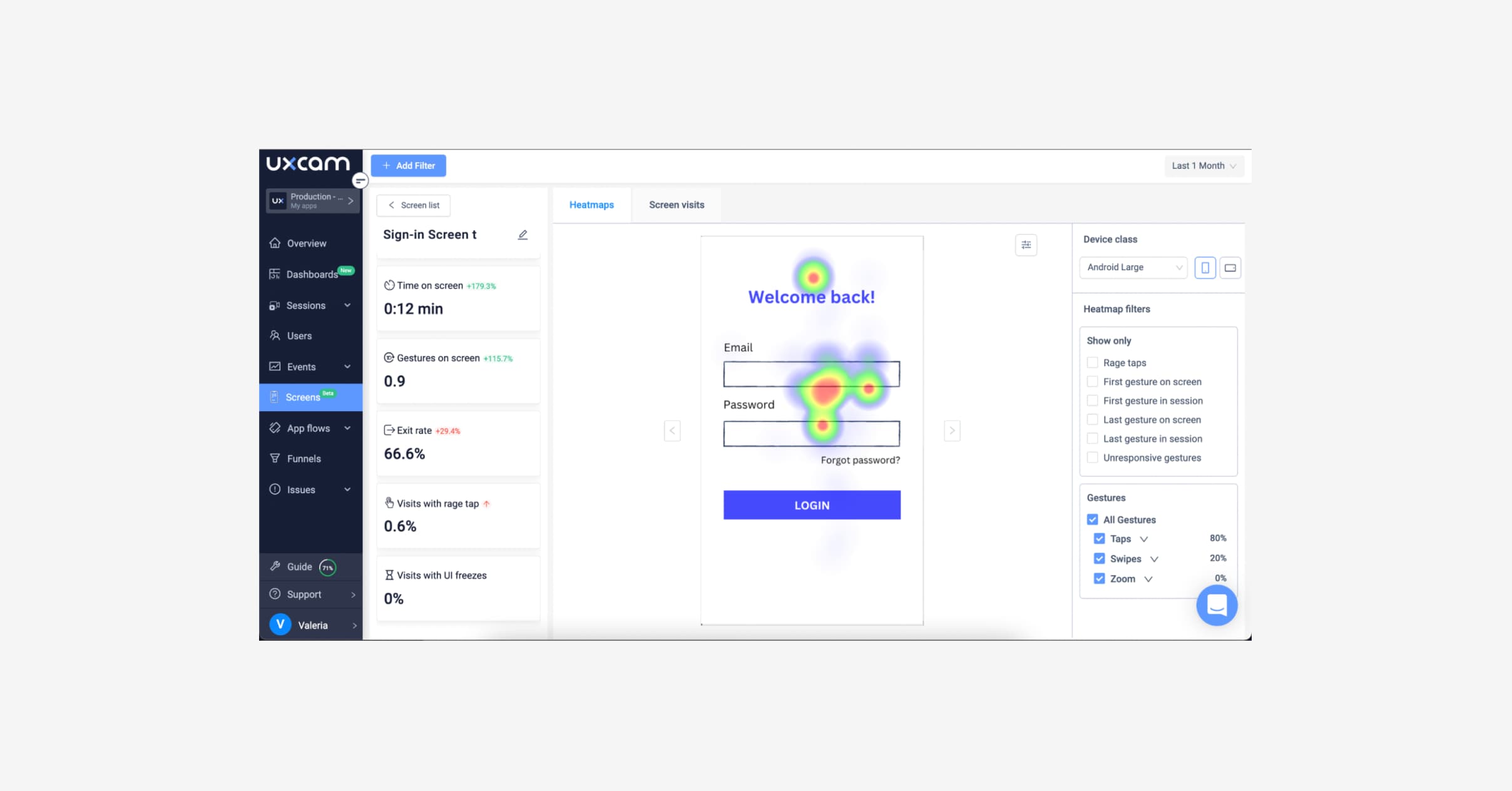Back to blog
7 MIN READ
What is Customer Journey Optimization? A Step-by-Step Guide
PUBLISHED
30 October, 2024

Product Analytics Expert
Optimizing your customer journey is a great way to develop a more personal relationship with your customers that leads to tangible benefits for your business.
Don't take our word for it, though — research shows that implementing customer journey management can boost marketing ROI by 10%, increase employee engagement by 25%, and drive customer retention by 2%.
If those sound like benefits you'd like to capitalize on, read on. This UXCam guide will be your roadmap to optimizing your customer journey in just six easy steps.
Summary - Customer journey optimisation
| Steps to Optimize the Customer Journey | Details and Best Practices |
|---|---|
| Assess your existing customer journey | Analyze customer interactions to spot patterns and inefficiencies. This identifies areas for improvement and sets priorities. |
| Clearly define your ideal customer | Create buyer personas using data on loyal and high-value customers to understand their needs and tailor the journey to them. |
| Segment before mapping | Group customers by demographics, behavior, and preferences to personalize marketing and enhance engagement. |
| Map the customer journey | Chart all customer touchpoints (e.g., website, app, email). Set metrics to evaluate touchpoint effectiveness using tools like UXCam. |
| Get customer feedback | Collect insights through surveys, reviews, and interviews to refine the journey and address pain points. |
| Make targeted improvements | Address bottlenecks using analysis, A/B testing, and experiments. Align changes with key metrics for impactful results. |
What is customer journey optimization?
Customer journey optimization is the process of systematically removing roadblocks in your customer journey to ensure that as many customers get from A to B as possible, as quickly as possible. More concretely, this means understanding your customer’s experience through data (qualitative and quantitative), and making targeted improvements to ensure that they have a delightful experience.
To give an example of this process in action, consider PlaceMakers’ experience with UXCam.

The team was concerned that many users were scrolling past products that matched their searches perfectly. They used UXCam’s session replay feature to investigate this customer journey roadblock and found that the culprit was a seemingly insignificant UI decision.
Since implementing UXCam and addressing small (but impactful) customer journey inefficiencies like this, they've doubled their sales.
How to optimize customer journey
Assess your existing customer journey
Clearly define your ideal customer
Segment before mapping
Map the customer journey
Get customer feedback
Make targeted improvements
Assess your existing customer journey
The first step in optimizing your customer journey is by assessing your existing assets. When using your website or app, what are the steps customers normally take? Doing this research allows you to find patterns and identify what you could be doing more effectively and efficiently.
Clearly define your ideal customer
To optimize the customer journey, it's essential to have a comprehensive understanding of your customers' needs and preferences.
This can be achieved by developing detailed buyer personas—fictional representations of your ideal customer. Every buyer persona you create should be based on market research and real data on your existing customer base.
When crafting your buyer persona, consider the following:
Which customers are most loyal?
Which customers recommend your business to others?
Which customers have the highest lifetime value?
Each of these questions gives you a different angle to assess which customers are the most important. Use user data to look for similarities and differences between segments and pull out key details to build your buyer persona.
Segment before mapping
Segmentation is the process of categorizing your customer base into separate groups based on various factors like:
Demographics
Behaviors
Purchase patterns
Psychographics
This enables you to customize your marketing strategies to meet the unique needs and preferences of each segment.

UXCam makes it easy to segment mobile app users by any property or attribute you have available and visualize user behaviors in each segment. Segments can be saved for future use and applied to any data set, visualization, report, or dashboard for easy insights.
Map the customer journey
The process of customer journey mapping means identifying customer interactions and examining how these interactions occur across various touchpoints.
This process doesn’t need to be challenging—here’s a three-step guide:
Understand your customer lifecycle. This means understanding how customers interact with your product or service and identifying which stages they progress to over time. This will usually be awareness → consideration → purchase → retention → advocacy.
Identify customer touchpoints. This means understanding all the potential places where customers interact with your brand at each stage—website, app, email, social media, etc.
Assign metrics to each touchpoint. This means setting success metrics for each touchpoint (e.g., how many people clicked on the link in your email). We do this to start measuring how specific touchpoints are contributing to your bottom line.
For in-app touchpoints, UXCam offers a range of tools for understanding user behavior. With it, you can measure things like average session length and page views to determine which features are being used most often.


UXCam also lets you create modular dashboards with pre-made and custom reports to track your metrics over time
Get customer feedback
Customer feedback is crucial for understanding how customers perceive their interactions with your brand. It can help you identify areas for improvement in the customer journey.
There are several effective ways to gather customer feedback and optimize the customer journey:
Conduct surveys: Create and distribute surveys to collect feedback from customers about their experience. You can use online survey tools or send personalized emails to gather valuable insights.
Social media monitoring: Keep track of social media platforms to gain insight into the opinions customers have about your brand. Pay attention to mentions, comments, and direct messages to identify areas of improvement.
Customer interviews: Conduct one-on-one interviews with selected customers to gain in-depth insights into their experiences. This allows for a more personal and detailed understanding of their journey.
Online reviews and ratings: Monitor and assess online feedback and ratings on various platforms like Yelp, Google, or specialized industry websites. These reviews can provide valuable feedback on specific touchpoints of the customer journey.
Live chat transcripts: By examining transcripts of live chat interactions, you can gain insights into recurring issues and identify the challenges that customers may be facing.
Customer feedback forms: Implement customer feedback forms on your website or at different touchpoints in the customer journey. This allows customers to provide feedback easily and directly.
Make targeted improvements
If at any point during your analysis you identify negative trends or patterns, it’s time to take action.
Start by identifying the root cause of a bottleneck or issue, and then brainstorm solutions with your team. Then use A/B testing, product experiments, and more to measure the impact of your efforts, determine whether the changes have been successful, and make data-driven decisions.
Finally, don’t forget to see how the changes you make impact high-level metrics—especially your North Star Metric.
Understanding the Customer Journey - A refresher
What is a customer journey?
A customer journey is the path a person takes from becoming aware of your product for the very first time to actively promoting it to friends, family members, coworkers, and peers.
The idea behind this concept is simple—on average, each customer’s experience shares a similar pattern of discovery, engagement, purchase, and loyalty. This journey experience can span a range of channels, including:
Organic and paid search
Websites and blogs
Trials and demos
Ads and promotions
Social media channels
Email marketing campaigns
By understanding this journey, you can reliably predict what a customer needs from you at any given time. This gives you a superpower—you can tailor your product and messaging to meet the customer’s needs as they move through their journey, increasing engagement, loyalty, and ultimately, revenue.
What are the 5 stages of customer journey?
The five stages of the customer journey are awareness, consideration, decision, retention, and advocacy.
In the awareness stage, a potential customer first discovers a need or problem and becomes aware of your brand. During consideration, they actively research and compare different solutions. The decision stage is when the customer chooses to make a purchase. Once they become a customer, the retention stage focuses on delivering value and maintaining engagement. Finally, in the advocacy stage, satisfied customers promote your brand through reviews, referrals, or word-of-mouth recommendations.
Why is understanding the customer journey important?
Empathize with customers
Understanding the customer journey allows businesses to step into their customers’ shoes and see their business from the customer’s perspective.
The purpose of this exercise is to support businesses in improving their understanding of the typical challenges faced by customers and how to enhance their overall experience. It provides valuable insights into customer needs and preferences.
Identify and fix roadblocks
By understanding the customer journey, businesses can effectively engage potential customers and influence their purchasing decisions. It helps in identifying potential bottlenecks or pain points in the customer journey that may be hindering conversions or causing customer churn.
Understand complex journeys
Today, the average consumer utilizes over three communication channels to interact with businesses. These various touchpoints contribute to the complexity of customer journeys, posing challenges in consistently delivering exceptional customer experiences. However, comprehending these intricate journeys can result in heightened customer satisfaction, enhanced loyalty, and ultimately, improved business performance.
Conclusion
Optimizing the customer journey is a multifaceted process that requires an in-depth understanding of your customers, thorough journey mapping, and continuous refinement. By walking in your customers' shoes, analyzing their interactions, and segmenting your audience, you can tailor experiences that resonate with your target market.
To expedite this process, consider leveraging tools like UXCam.
UXCam empowers mobile app teams with granular insights to develop empathic products, allowing you to step into your customers' shoes and understand their journey through real user behavior analytics.
Try UXCam now for free today.
FAQs
Customer journey optimization FAQs
Why is customer journey optimization important?
Optimizing the customer journey helps reduce friction, boost satisfaction, and increase conversion rates. It ensures customers receive relevant messaging and seamless experiences across all touchpoints, leading to stronger loyalty and higher lifetime value.
What are the key stages in a customer journey?
The key stages include:
- Awareness – discovering your brand
- Consideration – comparing solutions
- Conversion – making a purchase or signing up
- Retention – staying engaged post-purchase
- Advocacy – referring or reviewing the brand
What tools are used for customer journey optimization?
Tools like UXCam, HubSpot, and Google Analytics help track customer interactions, analyze user behavior, personalize experiences, and identify drop-off points in the journey.
What’s the difference between customer journey mapping and optimization?
Customer journey mapping visualizes current user flows and pain points. Customer journey optimization uses that map, along with behavioral data, to improve those experiences through testing, personalization, and automation.
You may also be interested in these;
How to analyze session recordings
Conversion funnel analysis - A comprehensive guide
Your guide to the mobile app customer journey
App user journey: Mapping from download to daily use
AUTHOR

Tope Longe
Product Analytics Expert
Ardent technophile exploring the world of mobile app product management at UXCam.
What’s UXCam?
Related articles
UX design
Auditoria de UX – Como Realizar uma (Etapas, Modelos e Checklist)
Navegue por auditorias de UX com facilidade usando nosso guia para iniciantes, com instruções passo a passo, modelos personalizáveis e um checklist...

Tope Longe
Product Analytics Expert
UX design
UX Audit - How to Conduct One (Steps, Templates & Checklist)
Navigate UX audits effortlessly with our beginner's guide, offering step-by-step instructions, customizable templates, and a detailed...

Tope Longe
Product Analytics Expert
UX design
12 UX Metrics to Measure and Enhance User Experience
Unlock product success by tracking the right UX metrics. Learn 12 essential metrics, how to measure them, avoid common pitfalls, and take action with tools like...